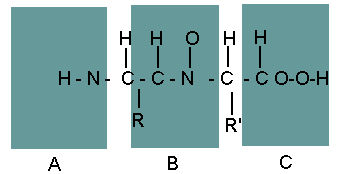Instructions: This
is a closed book, closed notes, INDIVIDUAL examination. You may,
however, have a calculator and use the scratch paper provided to
assist you with working the problems on this exam. The multiple choice
questions are each worth 4 points. Others are as marked. Show your
work as appropriate to provide the opportunity for partial credit.
Circle and Write your legible selection for each multiple choice.
Good luck.
1. Only one of the following is a true
statement concerning transcription of messenger RNA. Which one?
|
|
a. Sigma factor binds at the site
for beginning transcription, and the rho factor signals an end.
b. tRNA is used to transfer the
amino acids to the ribosome
c. The 50S ribosomal subunit binds
to the message at an initiation site, then the tRNA for formyl
methionine binds, then the 30S subunit binds
d. mRNA is read 3� to 5� to make
protein
e. The codon AUG marks the
beginning of transcription
|
|
2. One of the following is a true
statement. Which one?
|
|
a. Prokaryotes have intervening
sequences (introns)
b. a sequence of about 150
adenines forms the 3� end of eukaryotic mRNAs
c. coding sequences (exons) are
interrupted by non-coding sequences in prokaryotic genes
d. Protein termination occurs at
the amino end
e. Capping occurs at the 3� end of
prokaryotic messenger RNA
|
|
3. Which of the following is essential
for RNA polymerase to bind an E. coli promoter?
|
|
a. sigma factor
b. snRNP
c. TFIID
d. U1
|
|
4. Which of the following is essential
for RNA polymerase II to bind a eukaryotic promoter?
|
|
a. sigma factor
b. rho
c. TFIID
d. U1
|
|
5. Which of the following is a critical
difference between RNA and DNA polymerases?
|
|
a. Ability to catalyze synthesis
of nucleic acids in the 5� to 3� direction
b. Ability to utilize DNA as a
template for complementary synthesis
c. Requires a 3� OH to initiate
synthesis
d. Both A and B
e. None of the above
|
|
The following represents a polypeptide.

6. Which box contains a peptide bond?
7. Which box contains the carboxyl
end of the peptide?
8. The form of genetic information used
directly in translation is:
|
|
a. DNA
b. cDNA
c. rRNA
d. mRNA
e. ribosomes
|
|
9. The process which ribosomes are
engaged in is called:
|
|
a. replication
b. disjunction
c. translation
d. transcriptione repair
|
|
|
10. The final messenger RNA in the
cytoplasm of higher plants and animals differs from that of bacteria
in that:
|
|
a. It has introns
b. It has a more complex promoter
c. It has a poly � A tail
d. It does not use the AUG start
signal nor the UAA stop signal
e. All of the above are true
|
|
11. In what stage of translation
is GTP not used?
|
|
a. initiation
b. elongation
c. translocation
d. termination
|
|
12. Specificity in translation is
obtained by all of the following except:
|
|
a. using specific tRNA synthetases
for each amino acid
b. using an anticodon
c. using degenerate triplet code
having codons for each amino acid
d. using RNA polymerase
|
|
13. Mutations are (choose the correct
answer):
|
|
a. caused by genetic recombination
b. heritable changes in genetic
information
c. caused by faulty transcription
of the genetic code
d. usually but not always
beneficial
|
|
The following events, steps or reactions
occur during E.coliDNA replication. For each of the following
questions select the entry which is most appropriate to the phrase
stated. Each entry in A may have more than one answer, and each entry
in B can be used more than once.
|
|
A Polymerase I
B. Polymerase III
C. Helicase
D. Primase |
|
E. Ligase
F. SSB Protein
G. Gyrase
H. None of these |
|
14. Unwinds the
helix
15. Prevents re-association of
complementary bases
16. Is an RNA polymerase
17. Is a DNA polymerase
18. Is the �repair� enzyme
19. Is the major elongation enzyme
20. Separates daughter molecules and
causes supercoiling
21. The splicing of introns toward a
mature mRNA is accomplished via an intermediary structure called the
|
|
a. Lariat
b. Holiday
c. Chi
d. Rolling circle
|
|
22. tRNA �wobble� is a result of
|
|
a. inconsistency in replication
b. third base degeneracy
c. ribosomal mistranslation at the
3' end
d. mismatch repair |
|
23. All proteins start with a unique AA
which is
|
|
a. formyl methionine
b.
amino acyldiamine
c.
threonine hydroxylate
d.
isoleucine |
|
24. Beadle and Tatum derived the
hypothesis that has become
|
|
a.
one gene one polypeptide
b.
one gene one polymer
c.
one gene one synthetic nucleotide
d.
one gene one transcript |
|
25. The structure of DNA was first
published in
